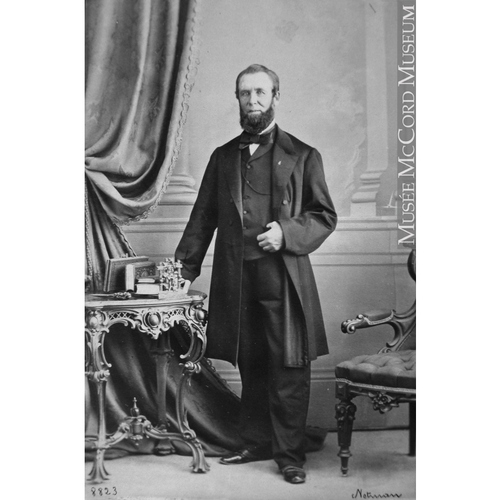CLARK, ALEXANDER, fisherman, mariner, settler, shipowner, and fur trader; b. 1818 in the parish of South Ronaldsay, Scotland; d. 26 April 1898 at Pointe aux Pins, Ont.
Like countless other Orkneymen before him, Alexander Clark joined the Hudson’s Bay Company. An experienced North Sea fisherman, in May 1839 he signed a contract to serve as a fisherman on Lake Superior. Disembarking at Moose Factory (Ont.) in late August, he soon set forth by canoe up the Moose and Missinaibi rivers to the Michipicoten and Pic posts and to his designated duties. After serving as a fisherman at Pic, he was assigned during the summer of 1841 to the crew of the Whitefish, the HBC’s supply ship on the lake. Clark served aboard this 50-ton schooner from 1841 to 1846 and early during this period he married Betsy, the Métis daughter of the vessel’s captain, Thomas Lamphier. Following his marriage, Clark appropriated a tract of crown land on the uninhabited Pointe aux Pins, adjacent to the schooner’s base at Sault Ste Marie, and he soon erected a substantial log house, the first white settler to establish a permanent homestead on the point.
At the close of navigation in 1846 Clark deserted the HBC. He soon found employment as a pilot, navigator, and schooner master. He commanded two schooners, the Napoleon (later converted into a propeller) and the Florence (owned by Allan Macdonell*), and piloted the steamer Rescue on its maiden voyage into Lake Superior under Captain Thomas Dick*. In 1851 Clark himself acquired a ship, a sloop of about 80 tons that he christened Rising Sun, and proceeded to transport passengers and freight to the mining locations and other settlements along the north shore of Lake Superior. Records reveal that Rising Sun made frequent passages through the ship canal at the St Marys Rapids between its opening in 1855 and the onset of the depression of 1857. The economic slump and the expanding network of railways took a heavy toll of Great Lakes shipping. As a consequence, Clark and other shipowners suffered from the loss of profitable cargoes, which forced them to lay up their ships.
Notwithstanding the fact that fur trading in the Lake Superior district had been declining since the 1830s, Clark, relying also on his competence in fishing, elected to return to the trade. In 1858 he occupied uninhabited crown land at Pays Plat, adjacent to Nipigon Bay, and proceeded with a partner to establish a trading post, “outfitted by connections of Dick’s,” according to HBC Chief Factor George Barnston*, and in direct competition with the nearby HBC posts, Long Lake and Nipigon House. During his seven-year stay at Pays Plat, Clark, in an effort to ensure that his remote establishment would remain self-sustaining, cleared 200 acres of forest for crops and pasture, and harvested trout, herring, and whitefish in the nearby bay for sale in the eastern markets.
Clark’s sojourn at Pays Plat was also marked by turbulence and conflict with the HBC. Like other energetic free-traders of his time, he attempted to equalize the difference in capital, organization, and manpower by adopting aggressive trading practices that frequently bordered on the thin edge of respectability, with whisky trading a major source of controversy. In 1864 or 1865 the shrinking supply of pelts (a result of overtrapping), the lack of interest in beaver on world markets, and increasing competition for the remaining furs convinced Clark that he should abandon his post and return to his homestead, to the life of a farmer.
During the period 1865–70 this energetic man, now approaching middle age, began to enlarge his acreage at Pointe aux Pins by clearing 200 acres of adjacent bush. In addition, he acquired a 1,500-foot lot next to Gros Cap on Whitefish Bay, where he also resumed his fishing activities. Under Ontario’s Free Grant and Homestead Act of 1868 he secured four other tracts of land at Gros Cap, which totalled 360 acres and for which he received final title in 1883. During the 1880s Clark possessed about 750 acres, much of which is now part of the city of Sault Ste Marie.
Clark’s wife died about 1879 and some time after 1881 he married a woman of Scottish background. He continued to operate his small farm and fishery, and in his final years assisted with the maintenance of the federal government’s range light opposite his homestead. Having navigated the “big lake” for 48 years, the old sailor passed away at his home in April 1898, survived by his six children. His monument stands in the West Korah Pioneer Cemetery in Sault Ste Marie.
AO, MU 838, T. G. Anderson diary, 1849 (typescript); MU 1385, box 2. NA, RG 31, C1, 1861, 1871, Algoma (mfm. at AO). National Arch. and Records Administration, Federal Arch. and Records Centre, Arch. Branch (Chicago), St Mary’s Falls ship canal, cash-book and reg. of vessels, 1855–57. Ont., Ministry of Natural Resources, Titles Section (Toronto), Crown land sales, Parke Township, sects.5, 24; Prince Township, sects.27, 32–33. PAM, HBCA, A.10/23: f.134; A.32/24: f.3; B.135/a/144: f.16d. “The steamer ‘Rescue,’ a pioneer in Great Lakes shipping,” ed. James McCannell, Thunder Bay Hist. Soc., Annual report ([Fort William (Thunder Bay), Ont.]), 1923: 11–14. C. M. MacIntyre, “Alexander Clark: fur trader – mariner, 1819–1898” (mimeograph, Toronto, 1987).
Cite This Article
Clark Martin MacIntyre, “CLARK, ALEXANDER,” in Dictionary of Canadian Biography, vol. 12, University of Toronto/Université Laval, 2003–, accessed December 24, 2025, https://www.biographi.ca/en/bio/clark_alexander_12E.html.
The citation above shows the format for footnotes and endnotes according to the Chicago manual of style (16th edition). Information to be used in other citation formats:
| Permalink: | https://www.biographi.ca/en/bio/clark_alexander_12E.html |
| Author of Article: | Clark Martin MacIntyre |
| Title of Article: | CLARK, ALEXANDER |
| Publication Name: | Dictionary of Canadian Biography, vol. 12 |
| Publisher: | University of Toronto/Université Laval |
| Year of publication: | 1990 |
| Year of revision: | 1990 |
| Access Date: | December 24, 2025 |



